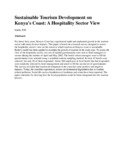| dc.contributor.author | Irandu, EM | |
| dc.date.accessioned | 2013-05-29T08:55:47Z | |
| dc.date.available | 2013-05-29T08:55:47Z | |
| dc.date.issued | 2006 | |
| dc.identifier.citation | Anatolia: An International Journal of Tourism and Hospitality Research Volume 17, Issue 2,pages 189-209 | en |
| dc.identifier.uri | http://www.tandfonline.com/doi/abs/10.1080/13032917.2006.9687186 | |
| dc.identifier.uri | http://erepository.uonbi.ac.ke:8080/xmlui/handle/123456789/26892 | |
| dc.description.abstract | For about forty years, Kenya's Coast has experienced rapid and unplanned growth in the tourism sector with many diverse impacts. This paper is based on a research survey designed to assess the hospitality sector's view on the extent to which tourism on Kenya's coast is sustainable Butler's model has been applied to examine the growth of tourism in the study area. To assess the view of the hospitality sector, two sets of mailed questionnaire were sent to hotel managers or owners during the months of April and May 2002. The hotels whose managers were to fill the questionnaire were selected using a stratified random sampling method. In total, 43 hotels were selected, but only 28 of them responded. About 560 employees in local hotels that had responded were randomly selected by hotel management and asked to fill the second set of questionnaire. The surveys revealed that tourism development at the coast has some positive and negative impacts. Today, the coastline experiences serious environmental degradation due to tourism related pollution. Social ills such as breakdown of traditions and crime have been reported. The paper concludes by showing how the local population could be better integrated into the tourism process. | en |
| dc.language.iso | en | en |
| dc.publisher | University of Nairobi | en |
| dc.title | Sustainable Tourism Development on Kenya's Coast: A Hospitality Sector View | en |
| dc.type | Article | en |
| local.publisher | Department of Geography & Environmental Studies, | en |

